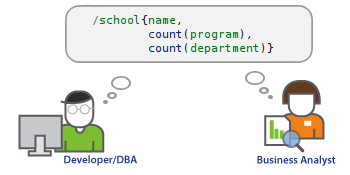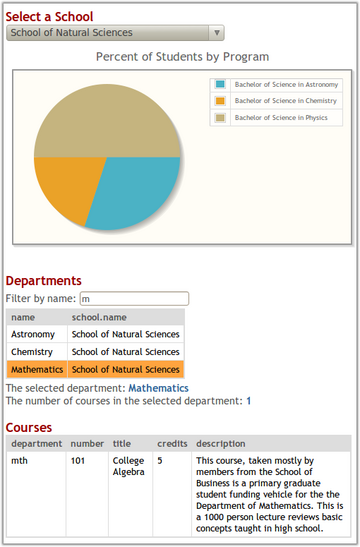
HTSQL is a comprehensive navigational query language for relational databases.
HTSQL is designed for data analysts and other accidental programmers who have complex business inquiries to solve and need a productive tool to write and share database queries.
HTSQL is free and open source software.
Advanced Query Language
HTSQL is a complete query language featuring automated linking, aggregation, projections, filters, macros, a compositional syntax, and a full set of data types & functions.
Relational Database Gateway
HTSQL requests are translated to efficient SQL queries. HTSQL supports different SQL dialects including SQLite, PostgreSQL, MySQL, Oracle, and Microsoft SQL Server.
Web Service Integration
HTSQL is a web service that accepts queries as URLs, returning results formatted as HTML, JSON, CSV or XML. With HTSQL, databases can be accessed, secured, cached, and integrated using standard web technologies.
Embedded Reporting
HTSQL is a backend framework supporting visual dashboard and reporting tools. HTSQL can be included in client-side Javascript or server-side Python applications. HTSQL plugins can provide domain specific customizations.
Development Environment
HTSQL includes a command line and web based query editor with syntax highlighting, context-sensitive completion, and error messages with tips and suggestions.
Communication Tool
HTSQL is used for collaboration among business users, data analysts, and application developers. HTSQL queries can be emailed, embedded in reports, and included in feature requests.
HTRAF Toolkit is a Javascript framework for embedding data into HTML pages. It can be used with HTSQL to quickly create attractive reports and dashboards.
<body>
<h3>Select a School</h3>
<select id="school"
data-htsql="/school{code, name}"></select>
<div style="width: 500px; height: 350px;"
data-htsql="/program{title, count(student)}
?school_code=$school&count(student)>0"
data-ref="school" data-type="pie" data-widget="chart"
data-title="Percent of Students by Program"></div>
<h3>Departments</h3>
<p>Filter by name: <input id="department_name"/></p>
<table id="department" data-hide-column-0="yes"
data-htsql="/department{code, name, school.name}
?school_code=$school&name~$department_name"
data-ref="school department_name"></table>
<p>
The selected department:
<em data-htsql="/department{name}?code=$department"
data-ref="department"></em> <br/>
The number of courses in the selected department:
<strong data-htsql="/department{count(course)}
?code=$department"
data-ref="department"></strong>
</p>
<h3>Courses</h3>
<table id="course"
data-htsql="/course?department_code=$department"
data-ref="department"></table>
</body>

The dashboard above shows a 3-level drill down (school, department, and course) for a university schema. For more examples like this, browse our Gallery.
HTSQL is free software. Prometheus Research offers support services, feature development, and sells license exceptions for use of HTSQL in combination with proprietary databases.
For more detail, please read about our HTSQL Licensing and HTSQL Community.
Exceptionally generous support for HTSQL has been provided by the Simons Foundation as part of its SFARI autism research initiative.
This material is based upon work supported by the National Science Foundation under Grant #0944460. Any opinions, findings, and conclusions or recommendations expressed in this material are those of the author(s) and do not necessarily reflect the views of the NSF.
HTSQL was developed by Clark C. Evans and Kirill Simonov, both of Prometheus Research.